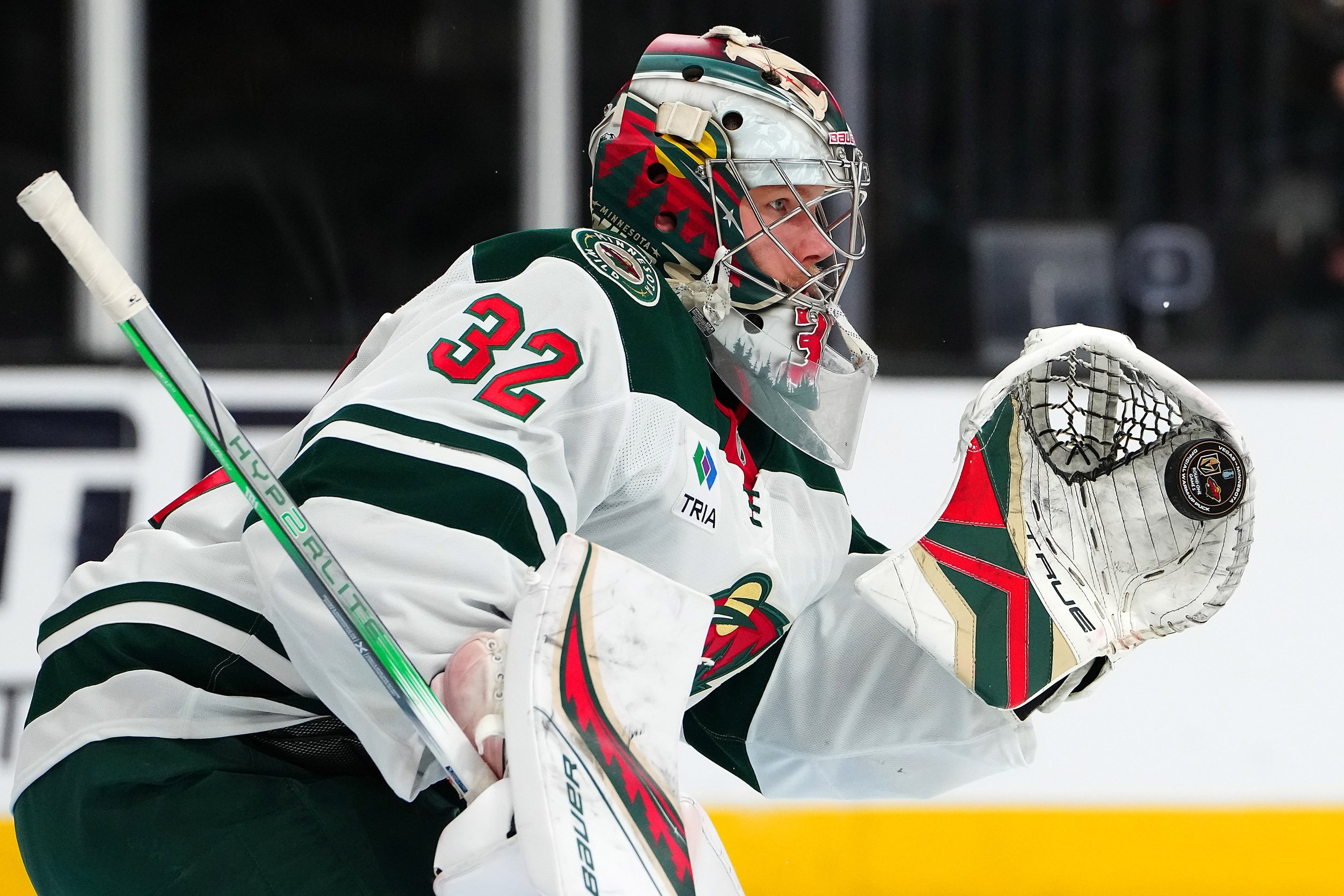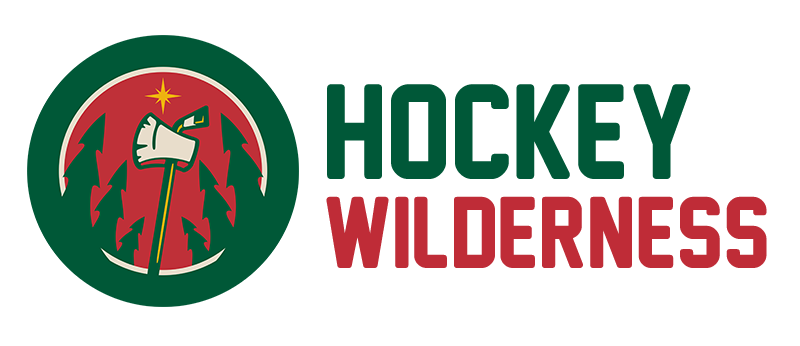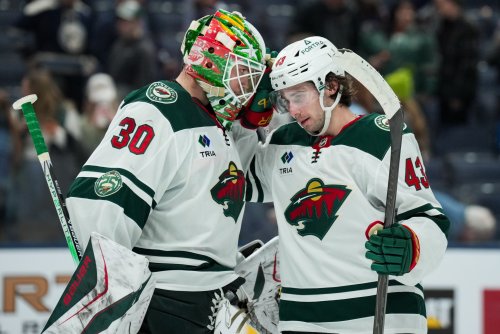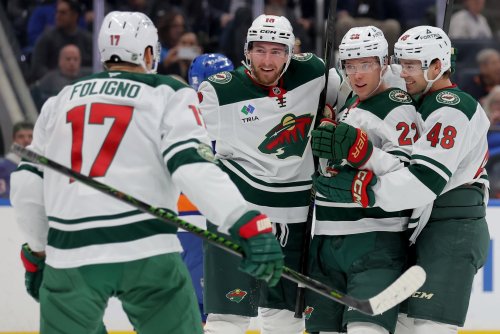
If the Minnesota Wild have historically been good at anything, it's been taking Perfectly Okay goalies and making them look like monsters. Thanks to the franchise having one or more of Jacques Lemaire, Mikko Koivu, and Joel Eriksson Ek on the team in all 24 of their seasons, strong defense is coded into the team's DNA. It's a rare year when Minnesota isn't one of the top teams in goal prevention.
That defense makes a lot of easy work for their goalies. A Vezina-contending goalie has never filled Minnesota's net, but anyone behind the Wild defense has a top save percentage. Dwayne Roloson (the franchise leader with a .919 save percentage), Josh Harding, Devan Dubnyk, Niklas Bäckström, Filip Gustavsson, Manny Fernandez, Cam Talbot, and Darcy Kuemper have posted career save percentages of .910 or higher with the club.
Of those eight goalies, seven of them have played elsewhere (Josh Harding is the only one to play his entire career for Minnesota). All but Darcy Kuemper have seen their numbers go down without the Wild's sturdy defense in front of them. Collectively, those seven combined for a .915 save percentage in a Wild sweater, and a .910 mark elsewhere. Back-of-the-napkin math suggests playing for Minnesota adds about five points of save percentage to your true talent level.
And that's going to be the trouble with the upcoming Filip Gustavsson contract negotiations, whenever those start. The "Gus Bus" has been a stabilizing force for the Wild in two of his three seasons. His first season in St. Paul saw him post a staggering .931 save percentage through 39 games, and his showing in 2024-25 (.914 in 58 games) earned him a couple of third-place Vezina Trophy votes.
It might not look like it at first glance, but Gustavsson can point to his numbers and argue for a big raise when he hits Unrestricted Free Agency next summer. A .914 save percentage looks good-but-not-great, especially in the context of Wild history.
However, over the last three years, there has been a league-wide spike in shooting percentage. Between the 2010-11 and 2016-17 seasons, the league shot under 9.00% in six of seven seasons. The one year they broke that barrier, they only mustered a 9.11% mark. Hardly the Wayne Gretzky Era, we're talking about.
It was a goalie paradise. Still, in each of the past three seasons, shooters have broken the 10% barrier. They started at 10.00% during Gustavsson's first season with the Wild, then bumped to 10.11% in 2023-24, then a full half-point to 10.60% last year.
What does that mean? Well, it used to be that any goalie under a .900 save percentage was one you wouldn't want to touch if you were Zdeno Chara holding Mats Zuccarello's stick. But let's look at Marc-André Fleury, who sat at .899 last season. That was five points higher than the league average!
And that means that Gustavsson's .914 mark was sixth in the NHL last season, and a whopping 20 points above league average. Looking at the low point of the 2010s Dead Puck Era, the 2013-14 season, the sixth-best goalie rocked a .924. That's probably the best way to look at Gustavsson's most recent campaign.
Not surprisingly, then, Gustavsson now finds himself among the best goalies in the NHL in pure, raw save percentage.
Here's a list of the league's top-10 (Minimum: 2,000 unblocked attempts faced):
- Connor Hellebuyck, .9214
- Linus Ullmark, .9209
- Anthony Stolarz, .9190
- FILIP GUSTAVSSON, .9137
- Ilya Sorokin, .9132
- Andrei Vasilevskiy, .9120
- Semyon Varlamov, .9117
- Jake Oettinger, .9106
- Logan Thompson, .9103
- Igor Shesterkin, .9102
That list says one thing:
The Gus Bus is gonna be hauling a lotta cash very soon.
Gustavsson's numbers exceed Logan Thompson's, who signed for six years with a $5.85 million AAV in January. They're better than Jake Oettinger, who signed a max-term contract with an $8.25 million cap hit. And Gustavsson has the edge on Lukas Dostal (.9030), who is making $6.5 million annually on a five-year deal he signed last month.
Gustavsson should be in that group, or at least, so says save percentage. But Minnesota has been in the league's top three in expected goals allowed at 5-on-5 for the past three years. The Wild defense is again expected to do the heavy lifting. So how can we account for that?
If you want to dive into advanced stats, Goals Saved Above Expected is a great entry point. The premise is surprisingly simple: How many goals did your goalie allow, and how many would we have expected an average goalie to make? You take a netminder's expected goals faced, subtract their actual goals allowed, and you get GSAx.
Through the lens of GSAx, Gustavsson suddenly looks somewhat pedestrian throughout his time in Minnesota. With just 27.88 GSAx, Gustavsson doesn't even rank among the NHL's top-10. Or top-20. Gustavsson ranks 23rd, sitting between Thatcher Demko and Sergei Bobrovsky. As for the goalies who are generally considered elite, the Hellebuycks, Sorokins, Shesterkins, Ullmarks, and Oettingers of the world? They're still in the top-10 once we account for defense.
That's good for the Wild heading into next year, when their defense should be intact and allow Gustavsson to shine again. Beyond that, however, it's terrifying. If the Wild are paying top-market rate for an above-average workhorse goalie, that could be a big problem down the road.
While Gustavsson is set to hit the market at age-28, the back end of any long-term deal is going to be a massive risk. Remember, Dubnyk was only 29 when he signed his six-year contract with the Wild, and the last two and a half seasons of that deal were disastrous.
It's easy to say that the Wild should walk from Gustavsson next year, based on all that. However, at the same time, a team needs a solid, reliable goaltender, and those aren't always easy to find.
If Jesper Wallstedt can't establish himself as the Goalie of the Future next year, then Minnesota might not have much choice but to pony up with a long-term deal for the Gus Bus. For a team in the middle of a five-year plan that supposedly ends with a Stanley Cup in St. Paul, Minnesota, can't risk switching to a 23-year-old goalie next season unless they're extremely sure he's up for it.
It's an unenviable situation for the Wild, and one that might not have an optimal resolution. Will they throw a lot of years and dollars at their established starter, even if his upside might be limited in terms of providing bang for the buck? Or do they start over and turn to a prospect, and hope for the best? It's one of the most important questions the State of Hockey must grapple with over the next 10 months.
Think you could write a story like this? Hockey Wilderness wants you to develop your voice, find an audience, and we'll pay you to do it. Just fill out this form.
-
 4
4






Recommended Comments
Join the conversation
You can post now and register later. If you have an account, sign in now to post with your account.
Note: Your post will require moderator approval before it will be visible.